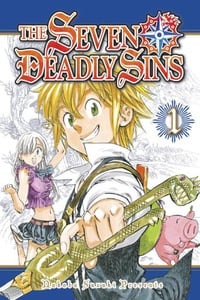Review
by Rebecca Silverman,The Seven Deadly Sins
GN 1
| Synopsis: |  |
||
Britannia appears to be a peaceful kingdom, but that surface image is about to change. One day Princess Elizabeth shows up at the door of the Pig's Hat Tavern and tells its owner Meliodas that the so-called Holy Knights have kidnapped her father the king. She's on a quest to bring back the maligned group known as the Seven Deadly Sins, because rumor has it that they're the only ones who can stand up to the Knights. To her surprise Meliodas can help her...because of a secret of his own. |
|||
| Review: | |||
In a fantasy England, the land is ruled by the good King Liones...or so everyone assumes. What they don't know is that the king has been deposed by his trusted Holy Knights, the supposed great protectors of the realm. His third daughter Elizabeth (no mention has been made thus far of the older children beyond that she's number three) witnessed the event, and decided to do something about it. Despite her fear and sheltered upbringing, Elizabeth set out to find the seven knights known as The Seven Deadly Sins. They were villainized ten years ago by the Holy Knights, and most Britannians believe that they're evil. As far as Elizabeth knows, however, they're the only ones who can restore her father to his throne. Fortunately for her, she quickly stumbles upon one of the seven, Meliodas, but...well, he looks like a kid and he's running a tavern. Good thing there's more to him than what you see on the surface. Despite Elizabeth being the nominal protagonist of the story, Meliodas fills that role more. Partly this is because Elizabeth, despite her grand ambitions, doesn't really do a whole lot. Yes, she finds Meliodas in the first place and is still determined to hunt down the rest of the Seven to save her father, but it's really clear that about all she has is that determination. While we could easily excuse this as her having been raised in a very sheltered environment – and really, “princess” is about as sheltered as they come in fiction, apart from “in a nunnery” – but that still sits a little uneasily with some of her actions, or rather the lack thereof. Probably that's due in large part to her acceptance of Meliodas' continued sexual harassment. She never utters a protest when he grabs her breasts or flips her skirt up “to measure” her behind, despite the fact that her face seems to indicate discomfort with these actions. Like in many shounen series (and shoujo, josei, and seinen, if we're being honest), this harassment is played for laughs. Your own tolerance will vary based on a variety of personal factors; if this is something that bothers you when presented as a comedic element, it is certainly something to consider before reading. Part of why this gets the comedy treatment is that Meliodas appears to be somewhere between ten and twelve years old. We're not sure why – and we certainly don't know how old he really is – but it clearly doesn't bother him very much. When called a child, he mildly tells people that he isn't and moves on with the conversation. Thus we see an apparent kid guzzling ale and engaging in other adult behaviors. It isn't all that jarring, honestly, because Meliodas doesn't act like a kid, something made clear in the second chapter when he interacts with an actual child. He's a really laid back protagonist, just sort of cruising through life, and it works for him. It could get to be an issue as the story heats up, but right now it's a nice difference from your usual hot-blooded shounen action hero. Nakaba Suzuki's art uses very little gray space – in fact there is almost no screen tone (unless some of the cross-hatching is in fact a cross-hatched tone) at all, with the pages being much more black and white than we usually see in contemporary manga. There are a couple of very noticeable influences in the way he draws people – Meliodas particularly has a real air of Akira Toriyama about him, and women's faces occasionally look like they came out of a 1970s shoujo piece. Suzuki tends to have problems with perspective, with it being very difficult to figure out how tall Elizabeth is in relation to Meliodas, and some issues with figures, such as the top and bottom of a body looking disconnected in some positions and arms ballooning into very large hands. Despite some issues, The Seven Deadly Sins' first volume is a pretty interesting, fun book. There's been mention of King Arthur and Merlin, which gives some hint as to time period and influences, and Meliodas' general air of joviality works. The reason his tavern is called “Pig Hat” is pretty great as well. If Elizabeth can become more of a functioning character (rather than just boobs for Meliodas to grope), this could be a series worth keeping an eye on – because I for one want to know what's up with these warring factions of knights. |
|
The views and opinions expressed in this article are solely those of the author(s) and do not necessarily represent the views of Anime News Network, its employees, owners, or sponsors.
|
| Grade: | |||
Overall : B
Story : B
Art : B
+ Very little gray space makes for interesting art, neat take on the basic knights-in-shining-armor story. Definitely liking the pigs. |
|||
| discuss this in the forum (9 posts) | | |||
| Production Info: | ||
|
Full encyclopedia details about Release information about |
||